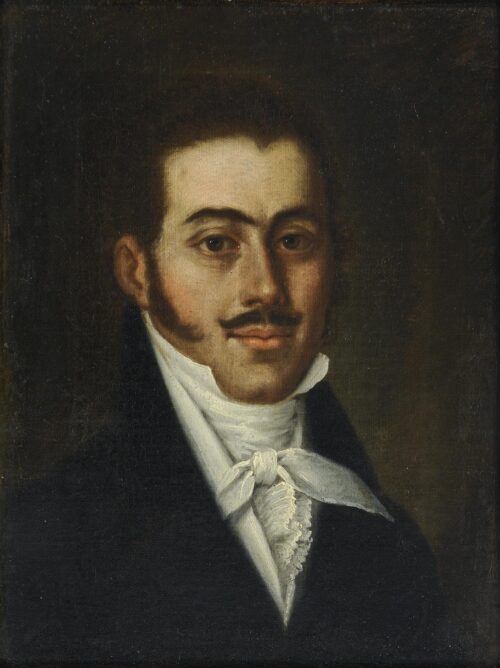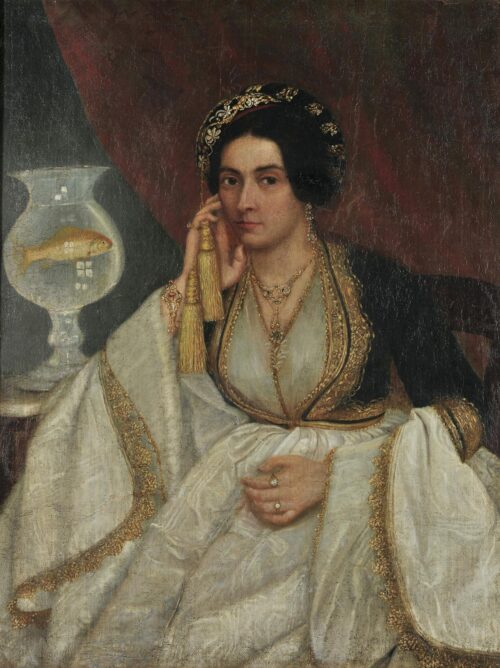
Pitzamanos Gerasimos (1787 - 1825)
Panagiotis Benakis, ca 1814-1825
Descendant of a family from Bohemia, he was the son of an icon-painter and priest, Vikentios Pitzamanos, from whom he took his first painting lessons. In 1804, during the Russian occupation, he was in Zakynthos where he was training under Nikolaos Kantounis. During the same year having enlisted in the staff of the Russian General Steter, he drew a large geographical map of the island showing the fortifications of the harbor and town. In 1807, with the return of the French Protectorate, he was awarded the rank of sergeant in the Engineering Corps and, in the same capacity, he was involved with the study and execution of fortification works. The following year he directed topographic works for the drawing up of maps of the islands and later went to Albania to draw a map of its coasts and mountains.
In 1809 he visited Ali Pasha on a special mission and the same year, with the approval of the Ionian Senate, at the command of Napoleon and at the expense of the state, he went to Rome, where he studied painting and architecture at the School of Fine Arts. In 1812 he was unanimously proclaimed an honorary member of St. Luke’s Academy while the following year the designs he was making for Napoleon’s triumphal arch for his wedding ceremony and his victories in Germany were presented at the Capitolio and Napoleon awarded him the Order of the Union. In 1814 he went to Paris where he continued his studies in painting, sculpture, architecture and engineering, and met Adamantios Korais.
In 1818, at the invitation of the English High Commissioner Maitland, he was appointed Professor of Architecture at the Ionian Academy of Corfu while later, with General Adam and his entourage, he visited Constantinople and various parts of Greece, gathering information on the manners and customs. He also wrote a study in French about Constantinople and did drawings and water colors with ancient monuments, landscapes, portraits and costumes. In 1820 he wrote a manual, Περί αρχιτεκτονικής (On Architecture) and later was a guest of the British ambassador in Constantinople and executed various other painting and architectural works. During the same period, at the recommendation of Ioannis Capodistrias, he was invited by the Tsar of Russia and appointed architect to the Court. But while working there he fell victim to tuberculosis and was forced to leave, first to Odessa and then Italy. When his illness was declared incurable, he returned to Corfu where he died in 1825.
His work, in addition to the water colors and drawings, contains portraits which were made into copperplates in Rome, the emblems of the Ionian islands, mythological scenes in the house of S. Pitzamanos in Argostoli and the illustration of churches in Corfu and Cephalonia.

Panagiotis Benakis, ca 1814-1825

Portrait of a Lady with a Fishbowl

We use cookies to make our site work properly, to personalize content and ads, to provide social media features and to analyze our traffic. We also share information about how you use our site with our social media, advertising and analytics partners. Read the Cookies Policy.
These cookies are necessary for the website to function and cannot be switched off in our systems. They are usually only set in response to actions made by you which amount to a request for services, such as setting your privacy preferences, logging in or filling in forms. You can set your browser to block or alert you about these cookies, but some parts of the site will not then work. These cookies do not store any personally identifiable information.
If you disable this cookie, we will not be able to save your preferences. This means that every time you visit this website you will need to enable or disable cookies again.
These cookies tell us about how you use the site and they help us to make it better. For example these cookies count the number of visitors to our website and see how visitors move around when they are using it. This helps us to improve the way our site works, for example, by ensuring that users find what they are looking for easily. Our website uses Google Analytics for statistics reporting.
Please enable Strictly Necessary Cookies first so that we can save your preferences!